
Yellowstone: A Testimony Erupted from Stone
Yellowstone was such an amazing place that those who heard the accounts of the early explorers thought they were just telling tall tales. Others who smelled the sulfur, heard the roaring steam vents, and saw the boiling mud pots thought for sure it was a connection to hell and the Devil himself. Yellowstone National Park sitting on an ancient volcanic caldera still causes wonder and awe, but is more of a paradise of amazing examples of God's creation than the fearsome names and descriptions given to many of its features.

We had so much fun exploring Yellowstone and the Grand Tetons with Belinda & Randall in September 2017.



We had so much fun exploring Yellowstone and the Grand Tetons with Belinda & Randall in September 2017.
Out of the eruption of the Yellowstone caldera and the subsequent movement of animals and humans arises three testimonies that can be clearly observed today in Yellowstone National Park regarding the validity of the Bible.
Testimony #1: Active
Yellowstone National Park has the largest collection of geothermal features in the world. There are over 10,000 hot springs, geysers, mud pots, and fumaroles - more than any other place in the world. Activity changes day-by-day and year-to-year. The geology of Yellowstone is very active and in constant change. But, why is there so much geothermal activity in this one location? This activity provides testimony that the forces at work in Yellowstone are not ancient, but are relatively young and still burning hot.

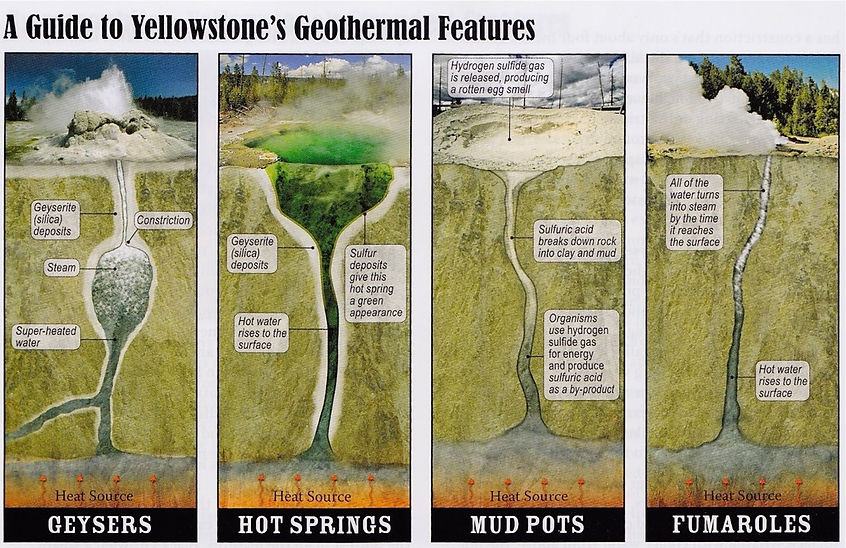
There are four types of geothermal features found in Yellowstone National Park. They all have the same source for their activity but what they do aboveground is largely based on what is happening below ground. Let's look at each type.

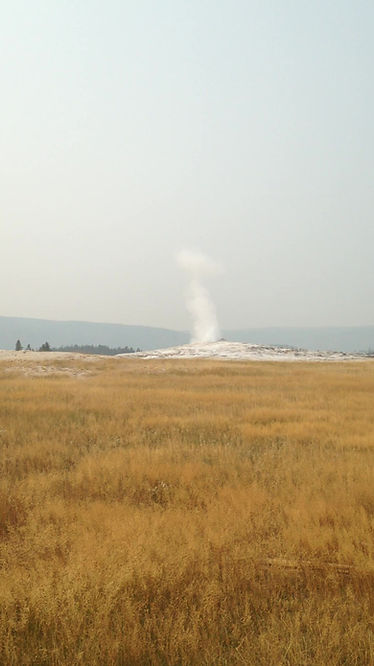
The most famous geyser in the world is Old Faithful. It is so named because its eruptions are fairly predictable and very regular. It will have an event roughly every 70 - 90 minutes.
Scroll down in the window above to view the webcam of Old Faithful and to find out when is the next eruption.
Geysers erupt because of a constriction in the underground "piping". The magma will heat groundwater transforming it into steam within an underground chamber. The constriction allows the steam to build up pressure until the chamber is sufficiently pressurized to empty itself of its contents. The regularity of a geyser depends upon the regularity of its water and heat source.


Hot springs have a direct connection of groundwater to the subterranean heat source but without the restriction that forms a geyser. However, because of the build up of Geyserite (opaline silica) and the changing of the subsurface due to geologic activity, hot springs can become geysers and geysers can turn into hot springs. Microscopic organisms called thermophiles (Greek word meaning "heat loving") live in hot springs and give them a very colorful look. Different types of thermophiles only exist in very narrow temperature ranges which creates an almost rainbow effect to be seen in the hot spring.
Green: 95°F
Brown: 110°F
Orange: 120°F
Yellow: 147°F
Blue: 198°F
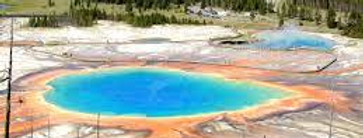

Steam
Clay Liner

A mud pot is a natural double boiler. Surface water collects in a shallow, impermeable (usually due to a lining of clay) depression that has no direct connection to an underground water flow. Groundwater beneath the depression converted to steam rises through the ground, heating the collected surface water.
Hydrogen sulfide gas is usually present, giving mud pots their characteristic odor of rotten eggs. Microorganisms consume some of the hydrogen sulfide gas for energy converting it to sulfuric acid, which breaks down rock into clay. The result is a gooey mix through which gases and steam gurgle and bubble.
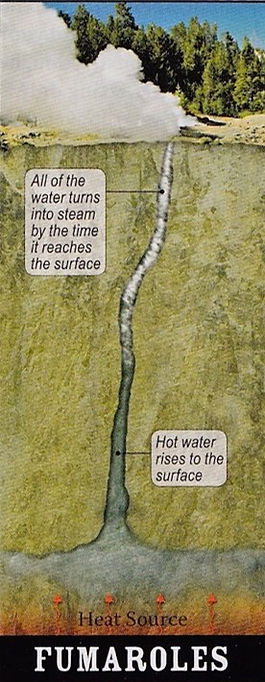
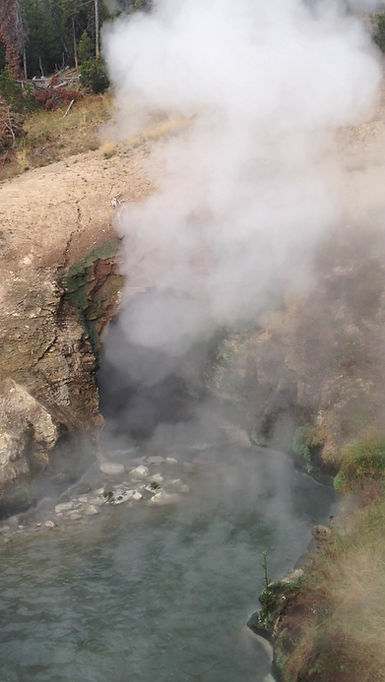
A fumarole, also called a steam vent, occurs when there is relatively little groundwater available in its system so that the water boils away before reaching the surface. Steam and other gases emerge from the fumarole sometimes with violent hissing or whistling. Fumaroles are often superheated, with temperatures as high as 238°F. Because of constantly changing geologic conditions, fumaroles can become geysers when additional groundwater becomes available and geysers can convert to fumaroles when groundwater conduits change or dry up.
What is the heat source for all these geothermal features? It is the supervolcano upon which Yellowstone sits. But, the extent of the surface and subsurface activity would indicate that this is not a dead volcano, but is still very much alive and, most likely, erupted far more recently than most geologists think. An age consistent with the Biblical narrative timeline would date the eruption approximately 4,500 to 3,500 years ago. But is this consistent with physical data? Many are surprised to find the Biblical dating to be more consistent than the secular 640,000-year estimate of the last Yellowstone eruption.
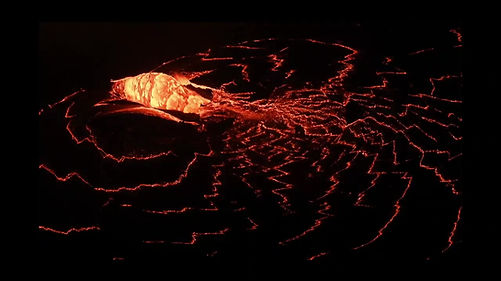

There are many types of volcanoes even found throughout the Western United States. Mount Shasta and Mount St. Helens are Composite Volcanoes, Hawaii has Shield Volcanoes, the local Sutter Buttes are a type of Dome Volcano, but Yellowstone represents the largest type of volcano - a Caldera or Supervolcano.
Approximately 20 different Supervolcanoes (rated at a Category 8 explosivity index) have been identified around the world. Supervolcanoes go through 3 stages:
-
Surge of magma - where the ground is pushed up (sometimes up to 20 feet or more) due to magma pooling in a hot spot.
-
Supereruption - the most violent volcanic explosion, but there are no current supereruptions occurring.
-
Resurgence - the formation of a caldera (which is the stage that Yellowstone is in currently).

The above National Geographic video provides a great explanation of supervolcanoes. However, as discussed in this website, we believe the time since the last eruptions to be significantly less than the 26,000 and 640,000 years mentioned in the video. It is important to note, that with even these dates, secular geologists who date the earth in billions of years are admitting the eruptions to be fairly recent. Their dating of these eruptions is based on rock dating methods that we discuss in the Yosemite and Grand Canyon testimonies.
Click Map to Magnify
According to geologist Dr. Andrew Snelling, modern volcanoes, such as Mount St. Helens, usually eject less than 3 cubic miles of ash. These modern eruptions, known as “nozzle eruptions,” are trivial next to the ancient supervolcanoes, which ejected ash in other ways. For example, Ice Age supervolcanoes, such as Long Valley and Yellowstone just after the Flood, ejected greater than 250 cubic miles of ash. Unlike nozzle eruptions, these were “ring-fissure eruptions.” They unzipped in vast circles, then collapsed to form calderas. Other even bigger supervolcanoes erupted earlier in history (late in the Flood). For example, the Independence Dike Swarm in southern California was caused when catastrophic plate tectonics opened numerous parallel fissures a hundred miles long. This massive eruption deposited the Brushy Basin Member of the Morrison Formation, which contains more than 4,000 cubic miles of ash and includes the gigantic mudflows that swept up and buried dinosaurs and many other creatures.

Today, volcanos produce annually approximately 1 cubic mile of ash and lava.
It is this fact about their activity that provides a great testimony to the validity of the Bible's geologic timeline.
Let's do the math ...

Assuming a uniformitarian approach (but clearly volcanism was much more prevalent in the past), for a period of 2.5 billion years, there would be produced 2.5 billion cubic miles of ash and lava. This is a problem, because the volume of the earth’s entire crust is 1.9 billion cubic miles; of which, it is estimated that 14.4% (or 274 million cubic miles) of it is derived from volcanic material. Even by uniformitarian standards, this by itself suggests that the earth is millions of years old and not billions. But, that is assuming 1 cubic mile per year. Clearly there were volcanic events (i.e. supervolcanoes) in the past that dwarf anything we have seen in our lifetime.
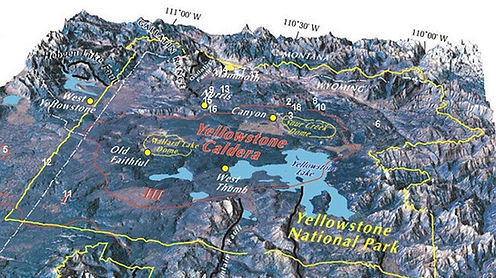
Yellowstone (and volcanoes, in general) provide a testimony to a young earth. The math and what we observe, do not “pencil-out” to billions of years. And, the fact that molten rock remains hot near the earth´s surface and is the source of the constant geothermal activity is evidence that Yellowstone´s volcanic activity was recent; fewer than 4,500 years ago, according to the Bible´s timescale.
Yellowstone is a Testimony Erupted from Stone.
Testimony #2: Animals

Then God said, “Let the earth produce every sort of animal, each producing offspring of the same kind—livestock, small animals that scurry along the ground, and wild animals.” And that is what happened. God made all sorts of wild animals, livestock, and small animals, each able to produce offspring of the same kind.
And God saw that it was good.
For all the animals of the forest are Mine, and I own the cattle on a thousand hills. I know every bird on the mountains, and all the animals of the field are Mine.
The Animals of Yellowstone have their own testimony to tell of God's marvelous creation. Yellowstone has one of the richest faunas in all of the continental United States. Not only can a visitor observe many types of animals, but you can also observe a relatively healthy ecosystem operating as God designed it to function with sustainability but adapting to the consequences of a fallen world.
There is much talk today about sustainability. Over the last several decades, our culture has elevated it to be a principle core value that is taught in our academic institutions and promulgated through our government. But, is sustainability a new concept? Is it something new our generation has developed? I think many might be surprised to learn that sustainability was actually a part of God's original design.
According to Genesis 1, God established the ecological system. A system that would be self-producing (sustainable). “Let the land produce vegetation: seed bearing plants and trees … that bear fruit with seed in it (vs. 11), … be fruitful and increase in number … fill the water in the seas and let the birds increase (vs. 22), … let the land produce living creatures (vs. 24) … God blessed them and said to them, “Be fruitful and increase in number; fill the earth and subdue it.” (vs. 28)”

sus·tain·a·bil·i·ty
/səˌstānəˈbilədē/
noun
Sustainability means meeting our own needs without compromising the ability of future generations to meet their own needs.
But, that was before Genesis 3 when sin entered the world.
As described in Genesis 3, as a consequence of disobedience to God’s law, creation was subjected by God to another master - bondage of decay.
-
Sin was the cause
-
The curse initiated a struggle to survive
-
Decay / entropy began

Today many look at the nature, climate, ecological systems, and even our own bodies and cannot help but note there has been some degradation from what it should be. We are noting the decay, and longing (or as Paul said in Romans 8, "groaning") for sustainability but it seems to be a losing battle. We blame man's effects on the ecosystem through the use of carbon fuels, the emission of green house gases, and pollution. That thinking is consistent with scripture in that the human race is the culprit. But, the negative human influence on our ecosystem started nearly 6,500 years ago in a garden - long before fossil fuels started to be used.
God's Instructions to Humans
At the beginning ...
-
Be fruitful and increase in number (Gen. 1:28)
-
Fill the earth and subdue it (1:28)
-
Rule over (have dominion) over creation (1:28)
-
To work the earth (2:5 & 2:15)
-
To take care of it (2:15)
At the fall ...
-
Pains in childbearing very severe; with painful labor you will give birth to children. (Gen.3:16)
-
Through painful toil you will eat food from the ground all the days of your life. (3:17)
-
By the sweat of your brow you will eat your food until you return to the ground. (3:19)
After the flood ...
-
Be fruitful and increase in number and fill the earth. (Gen. 9:1)
-
On all the birds in the sky, on every creature that moves along the ground, and on all the fish in the sea; they are given into your hands. Everything that lives and moves about will be food for you. (9:3)
-
And for your lifeblood I will surely demand an accounting. I will demand an accounting from every animal. And from each human being, too. (9:5)
Sustainability
Decay
Adaptive Sustainability
Mankind's sin brought decay and death. The world and its inhabitants were no longer eternally sustainable but were now subject to pain, sweat, heartache, and having to adapt to a new way of life. But, God had already foreseen this and built into His creation adaptability. God doesn't need to adapt, because He does not change (Psalm 102:25-27). However, His groaning creation needed the ability to adapt to the deadly effects of sin. God built this adaptability into the physical bodies of the animal kingdom and, to a certain extent, in humans. But, spiritually, humans cannot adapt to the effects of sin, so God provided another solution.

Life now involves a struggle to survive.
Watch these videos on the adaptability of wolves, beaver, and the Yellowstone ecosystem.

Evolving or Adapting?
a·dapt·a·bil·i·ty
/əˌdaptəˈbilədē/
noun
Adaptability means variability in respect to, or under the influence of, external conditions; susceptibility of an organism to that variation whereby it becomes suited to or fitted for its conditions of environment; the capacity of an organism to be modified by circumstances.
There is a big difference between evolving and adapting. Evolving has the connotation of upward mobility - improving. Adapting has the connotation of survival. Secular biologists claim adaptation is the mechanism for evolution. Biblical biologists believe adaptation is a God-given trait included in His creation. Which perspective is right? You will need to decide. But, we can look around us at the evidence. Do we see nature in a state of improvement or in a state of decay? Is the ecosystem inherently sustainable or adaptively sustaining? Be careful how you answer, because one conclusion will result in a need to re-write the Second Law of Thermodynamics.
Adaptive Sustainability
God’s Design for Surviving the Curse of Sin
Creation Groaning
Selfishness
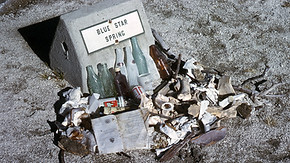
Trash recovered from the Blue Star Spring
Keeping God's Creation Mandates
Stewardship

Volunteers in action
40 million bison killed in the 1800’s, with only 1,000 left in 1910.

Historic wildfires due to a century of full suppression policy.
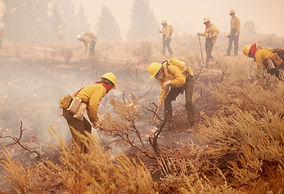
Today, through conservation policies, there are now 500,000 bison, and 5,000 in Yellowstone

Learning to manage forests (a creation mandate) and the natural role of fire.
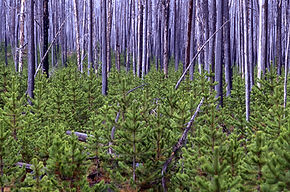
Up to 400 million beaver were killed by fur trappers in the 1700’s and 1800’s; however, even after the fur trade stopped, beavers declined in Yellowstone until recently.

Because wolves are back, beaver are on a come back with 100 beaver colonies now existing.

The curse of sin is death
Yellowstone
Cemetery
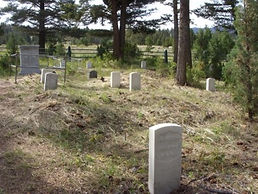
The curse is removed, and life is given through Christ’s death on the cross.

Testimony #3: Anthropic - Geographic Movement of Humans

Anthropic
an·throp·ic
an-ˈthrä-pik
adjective
Of or relating to human beings or the period of their existence on earth
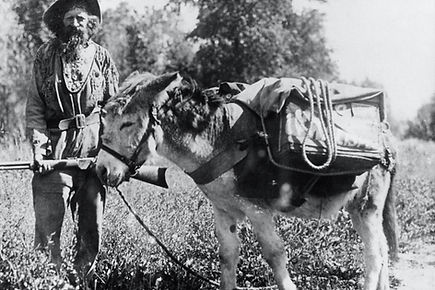
History of Man
What we believe about the origins of man is dependent exclusively on what we believe about God. If our world view does not include the possibility of a creator God, we must then turn to other explanations such as evolution. However, if we believe in an all-powerful and all-resourceful God, then the creation of human beings is not only possible but is also very plausible. Scientific hypotheses (ideas) are dependent upon our presuppositions, or, in other words ... faith.
Then God said, “Let Us make human beings in Our image, to be like Us. They will reign over the fish in the sea, the birds in the sky, the livestock, all the wild animals on the earth, and the small animals that scurry along the ground.” So God created human beings in His own image. In the image of God He created them; male and female He created them.
Secular World View

300,000 years

Biblical World View
Flood
4,500 years
Now


How did humans (and animals) migrate to distant and remote continents after the flood?
During the post-flood ice age, so much water was in the form of ice and glaciers that ocean levels were significantly lower allowing land bridges to exist between Asia and North America, and between Asia and Australia. During the ice age, more than 4,000 feet of ice covered most of Yellowstone.
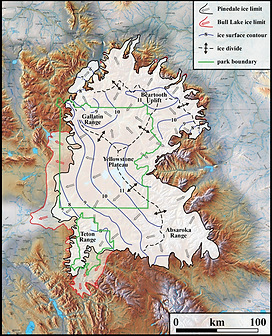
Blue contours are 1,000's of Feet
At one time all the people of the world spoke the same language and used the same words. As the people migrated to the east, they found a plain in the land of Babylonia and settled there. They began saying to each other, “Let’s make bricks and harden them with fire.” (In this region bricks were used instead of stone, and tar was used for mortar.) Then they said, “Come, let’s build a great city for ourselves with a tower that reaches into the sky. This will make us famous and keep us from being scattered all over the world.” But the Lord came down to look at the city and the tower the people were building. “Look!” he said. “The people are united, and they all speak the same language. After this, nothing they set out to do will be impossible for them! Come, let’s go down and confuse the people with different languages. Then they won’t be able to understand each other.” In that way, the Lord scattered them all over the world, and they stopped building the city. That is why the city was called Babel, because that is where the Lord confused the people with different languages. In this way he scattered them all over the world.
History of Yellowstone from a Biblical World View

Yellowstone Migrations
1400s - 1800s Tribes of Yellowstone:
Assiniboine and Sioux
Blackfeet
Cheyenne River Sioux
Coeur d’Alene
Comanche
Colville Reservation
Crow
Crow Creek Sioux
Eastern Shoshone
Flandreau Santee Sioux
Gros Ventre and Assiniboine
Kiowa
Little Shell Chippewa
Lower Brule Sioux
Nez Perce
Northern Arapaho
Northern Cheyenne
Oglala Sioux
Rosebud Sioux
Salish and Kootenai
Shoshone–Bannock
Sisseton Wahpeton
Spirit Lake
Standing Rock Sioux
Tukudika (Sheep Eaters)
Turtle Mountain Band of the Chippewa
Umatilla Reservation
Yankton Sioux
Washakie & his warriors; Photographer unknown; 1871. Washakie was a prominent leader of the Shoshone people during the mid-19th century. He was first mentioned in 1840 in the written record of the American fur trapper, Osborne Russell. In 1851, at the urging of trapper Jim Bridger, Washakie led a band of Shoshones to the council meetings of the Treaty of Fort Laramie.

1700s - 1800s Mountain Men of Yellowstone:
French trappers
Jim Bridger
Joe Meek
Jedediah Smith
Daniel Potts
David Jackson
Johnson Gardiner
Warren Ferris
Osborne Russell
Marcus & Narcissa Whitman (1836)
John Colter

"…the whole country was smoking with the vapor from boiling springs, and burning with gasses, issuing from small craters, each of which was emitting a sharp whistling sound." - John Colter
1869 - 1871 Early Expeditions in Yellowstone:
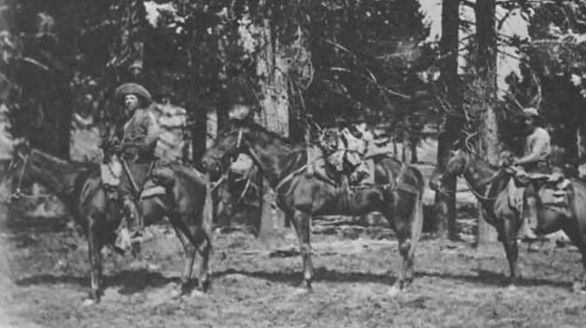
Grand Canyon of the Yellowstone; photographed by William H Jackson and painted by Thomas Moran in 1871
1877 Chief Joseph and the Nez Perce Flee Across Yellowstone:
Chief Joseph led his band of Nez Perce during the most tumultuous period in their history, when they were forcibly removed by the United States federal government from their ancestral lands in the Wallowa Valley of northeastern Oregon onto a significantly reduced reservation in the Idaho Territory. A series of violent encounters with white settlers in the spring of 1877 culminated in those Nez Perce who resisted removal, including Joseph's band and an allied band of the Palouse tribe. They then attempted to flee the United States to reach political asylum alongside the Lakota people, who had sought refuge in Canada under the leadership of Sitting Bull.
At least 700 men, women, and children led by Joseph and other Nez Perce chiefs were pursued by the U.S. Army under General Oliver O. Howard in a 1,170-mile fighting retreat known as the Nez Perce War. The skill with which the Nez Perce fought and the manner in which they conducted themselves in the face of incredible adversity earned them widespread admiration from their military opponents and the American public. Coverage of the war in U.S. newspapers led to popular recognition of Chief Joseph and the Nez Perce. In October 1877, after months of fugitive resistance, most of the surviving remnants of Joseph's band were cornered in the northern Montana Territory, just 40 miles from the Canadian border. Unable to fight any longer, Chief Joseph surrendered to the Army with the understanding that he and his people would be allowed to return to the reservation in western Idaho. He was instead transported between various forts and reservations on the southern Great Plains before being moved to the Colville Indian Reservation in the State of Washington, where he died in 1904.


The Migration Continues Today:


Since 2015, over 4 million visitors per year have migrated to Yellowstone. The one exception was 2020, due to COVID and the park being closed for a few weeks, the visitation dropped to 3.8 million.
The National Park Service is the agency responsible for the care, maintenance, and administration of national treasures like Yellowstone National Park. Their mission is to preserve unimpaired the natural and cultural resources and values of the National Park System for the enjoyment, education, and inspiration of this and future generations.

-
Even by secular dating methods, the earliest tribes to occupy Yellowstone date only to 10,000 years ago (although oral histories are more in line with a Biblical timeline of 3,000 years ago.) Most likely, the glaciers from the post-flood ice age prohibited entry into the Yellowstone basin any earlier than 3,000 - 4,000 years ago.
-
It was not that long ago when Yellowstone was first explored by the U.S. government; my great-grandparents were alive at that time.
Anthropic Testimony of Yellowstone National Park

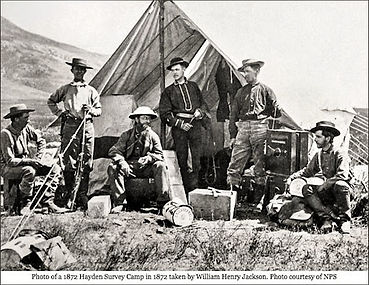
-
Today, we migrate to national parks, because the splendor of God’s creation draws us to awe and admiration of His power and creative work – whether we know it or not.
The whole earth is filled with awe at Your wonders; where morning dawns, where evening fades, You call forth songs of joy.
-
Therefore, man is a relatively newcomer to this region.
-
This timeline coincides perfectly with world geologic and anthropic history as described in the Bible.
-
Secular history dates the first homo sapiens around 300,000 years ago. If this is true, a valid question is “why did it take them so long to get to Yellowstone, especially with multiple ice ages enabling land bridge access?”




